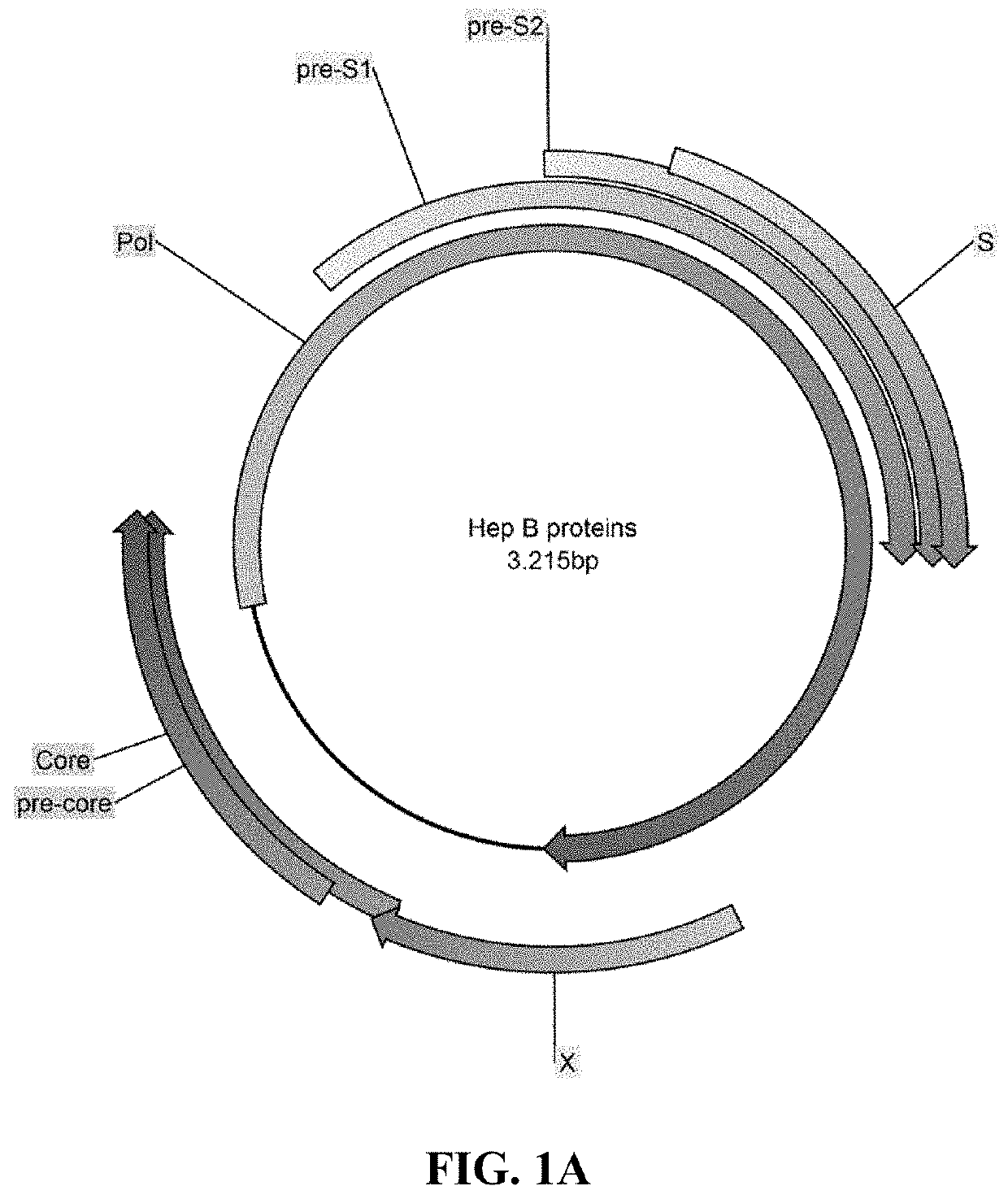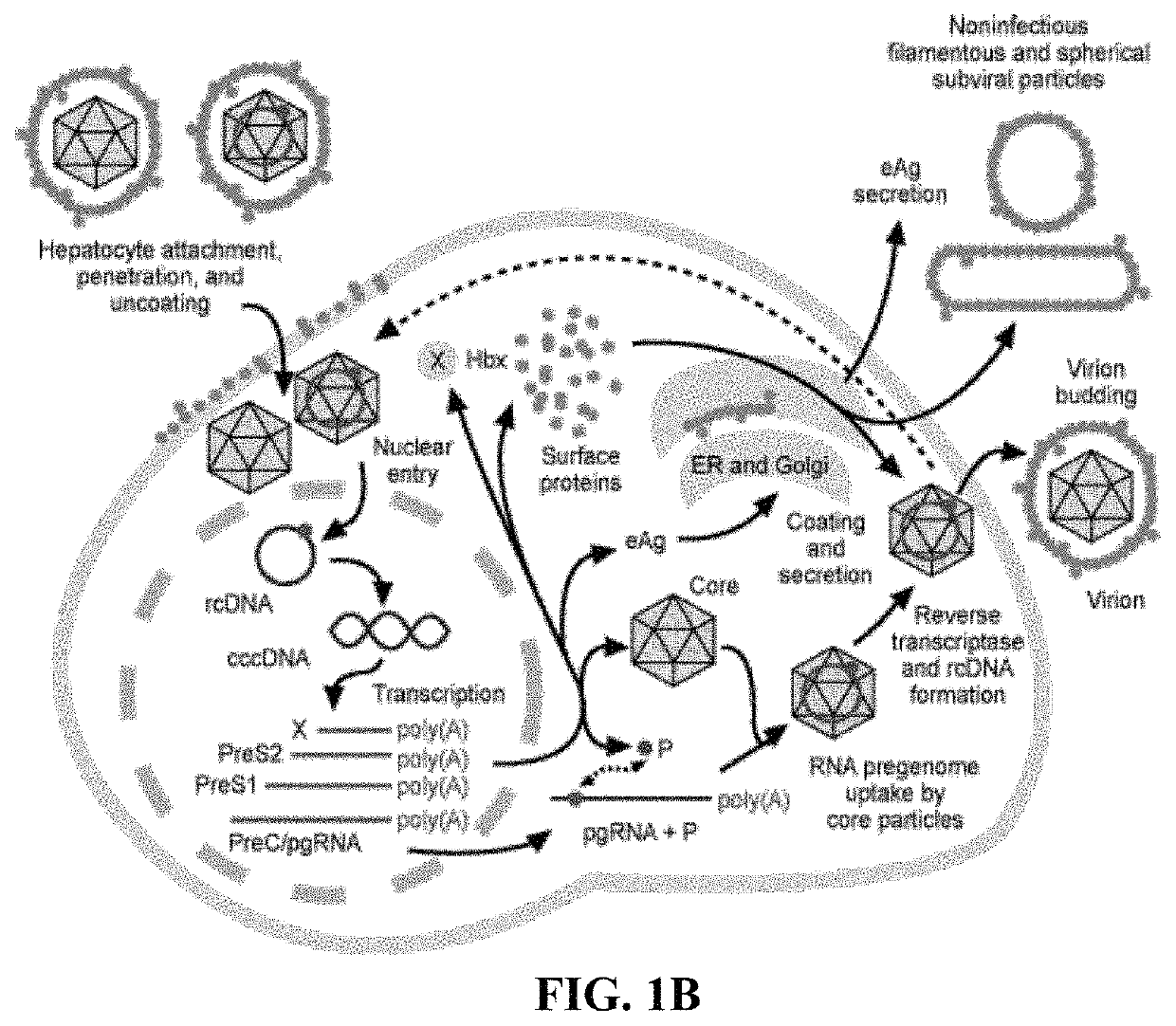Methods and compositions for inducing an immune response against Hepatitis B Virus (HBV)
a technology of immune response and hepatitis b virus, applied in the field of biotechnology, can solve the problems of no ultimate cure, limited effect of cccdna, and inability to cure established hbv infection, and achieve the effect of improving the cure ra
- Summary
- Abstract
- Description
- Claims
- Application Information
AI Technical Summary
Benefits of technology
Problems solved by technology
Method used
Image
Examples
example 1
n of HBV Core and Pol Antigen Sequences
[0370]T-cell epitopes on the hepatitis core protein are considered important for elimination of hepatitis B infection and hepatitis B viral proteins, such as polymerase, may serve to improve the breadth of the response. Thus, hepatitis B core and polymerase proteins were selected as antigens for the design of a therapeutic hepatitis B virus (HBV) vaccine.
[0371]Derivation of HBV Core and Polymerase Antigen Consensus Sequences
[0372]HBV pol and core antigen consensus sequences were generated based on HBV genotypes B, C, and D. Different HBV sequences were obtained from different sources and aligned separately for core and polymerase proteins. Original sequence alignments for all subtypes (A to H) were subsequently limited to HBV genotypes, B, C, and D. Consensus sequences were defined for each protein alignment in each subtype separately and in all joint BCD sequences. In variable alignment positions, the most frequent amino acid was used in the c...
example 2
n of Adenoviral Vectors Expressing a Fusion of Truncated HBV Core Antigen with HBV Pol Antigen
[0379]An adenovirus vector was created to express a fusion protein of a truncated HBV core antigen and a HBV pol antigen from a single open reading frame. Additional configurations for the expression of the two proteins (e.g., the truncated HBV core antigen and the HBV pol antigen), e.g. using two separate expression cassettes, or using a 2A-like sequence to separate the two sequences, can also be envisaged.
[0380]Design of Expression Cassettes for Adenoviral Vectors
[0381]The expression cassettes (diagrammed in FIG. 2A and FIG. 2B) comprise the CMV promoter (SEQ ID NO:7), an intron (SEQ ID NO: 15) (a fragment derived from the human ApoAI gene—GenBank accession X01038 base pairs 295-523, harboring the ApoAI second intron), followed by the optimized coding sequence—either core alone or the core and polymerase fusion protein preceded by a human immunoglobulin secretion signal coding sequence (S...
example 3
n of MVA Vectors Expressing a HBV Core Antigen and a HBV Pol Antigen
[0385]An MVA vector has been designed to encode each of the HBV Core and Pol coding sequences of the application. Each of the HBV Core and Pol coding sequences were inserted into an MVA vector at IGR44 / 45, each under the control of a separate promoter. Additional configurations for the expression of the two proteins, e.g. using a single expression cassette wherein the Core and Pol antigen comprise a fusion protein, or alternatively utilizing a 2A-like sequence to separate the two sequences, can also be envisaged. Further, additional and / or alternative insertions sites in the MVA vector can also be envisaged, e.g., inserting each of the HBV Core and Pol coding sequences into the same or different insertion sites.
[0386]Design of Expression Cassettes for MVA Vectors
[0387]The expression cassettes (diagrammed in FIG. 2C) are comprised of the Pr13.5 long promoter (SEQ ID NO: 25) adjacent to and directing expression of the...
PUM
| Property | Measurement | Unit |
|---|---|---|
| size | aaaaa | aaaaa |
| time | aaaaa | aaaaa |
| concentration | aaaaa | aaaaa |
Abstract
Description
Claims
Application Information
 Login to View More
Login to View More - R&D
- Intellectual Property
- Life Sciences
- Materials
- Tech Scout
- Unparalleled Data Quality
- Higher Quality Content
- 60% Fewer Hallucinations
Browse by: Latest US Patents, China's latest patents, Technical Efficacy Thesaurus, Application Domain, Technology Topic, Popular Technical Reports.
© 2025 PatSnap. All rights reserved.Legal|Privacy policy|Modern Slavery Act Transparency Statement|Sitemap|About US| Contact US: help@patsnap.com



